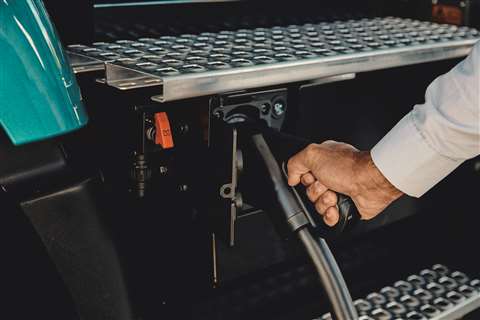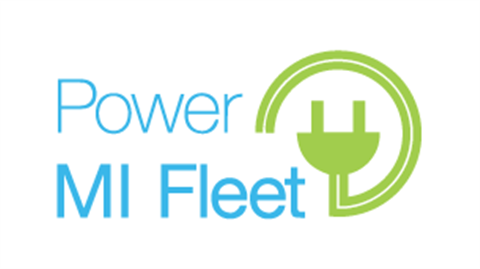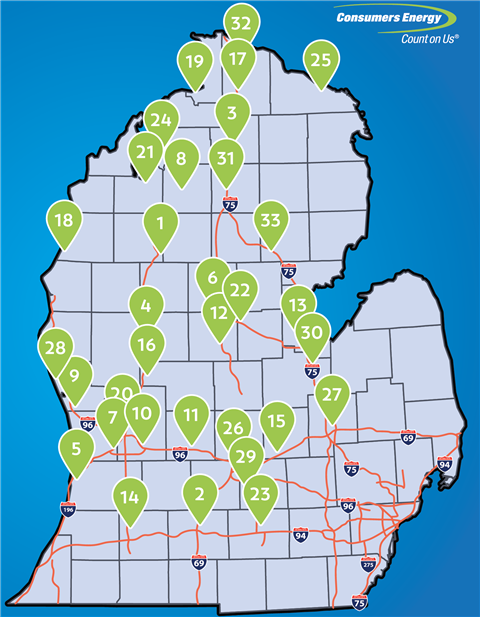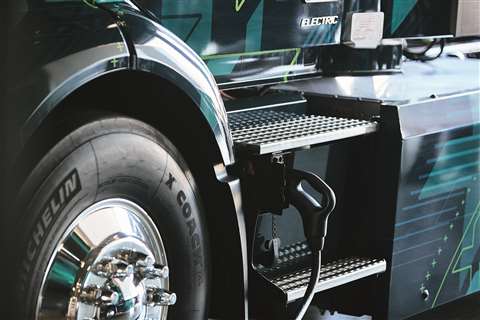Electric vehicle growth requires utilities to get creative
24 May 2022
Advance work by utilities will help sustain electrical grid and ease transition to electrification
 While many are concerned about whether the electrical grid can handle an influx of electric vehicles, the reality is there is more than sufficient capacity, so long as the recharging demand is properly managed, Consumers Energy said. (Photo: Volvo Trucks North America)
While many are concerned about whether the electrical grid can handle an influx of electric vehicles, the reality is there is more than sufficient capacity, so long as the recharging demand is properly managed, Consumers Energy said. (Photo: Volvo Trucks North America)
When people consider electrification, they often tend to look at only one side of the equation – the vehicles and machines that are transitioning to battery power and moving away from internal combustion engines.
Yet equipment is only half of the electrification equation. Just as vital is the electrical grid through which those vehicles and machines are charged and recharged.
Conventional wisdom holds that a fast or even moderate adoption rate for electrically driven vehicles (e-vehicles or EVs) could wreak havoc in the electrical grid, conjuring images of skyrocketing electricity rates and even brownouts and blackouts.
The real picture, however, is much less grim, thanks in large part to some creative advance work being done by utilities across the country.
A good example is Consumers Energy, an electrical and natural gas utility that serves approximately 6.8 million customers in Michigan’s lower peninsula. Over the last several years, the company has established pilot programs designed to manage the transition toward e-vehicles in the smoothest, most cost-effective manner possible.
Programs begin
The PowerMIDrive program, which began in mid-2019, targets consumers and commercial customers, offering $500 rebates for consumers to install Level 2 chargers at their homes and up to $5000 for commercial customers for installation of public Level 2 charging installations. It also provides as much as $70000 to commercial customers for installation of publicly accessible dc fast chargers.
PowerMIDrive led to the installation of nearly 200 public Level 2 charging installations across Michigan, along with 37 public dc fast charging locations along the state’s major four-lane highways and arterials.

More recently, the PowerMIFleet program, which commenced in mid-2021, focuses on Michigan businesses, offering electrification consulting services and as much as $3 million in rebates to business fleets to add charging locations.
“PowerMiFleet is really looking at how we can help our C&I, our commercial, industrial and our municipal and government customers transition their fleets and learn along with them what’s going to be successful,” said Jeff Myrom, director of Electric Transportation Customer Programs at Jackson, Mich.-headquartered Consumers Energy. “And do we need to change planning standards or design standards in certain areas for these customers as we see that happen?
“Our whole goal with all of these electric vehicle programs is to find out how do we need to optimize the grid? And how do we fill in the off-peak periods, which for us is largely overnight when electric use can drop in half or more? So the idea is, let’s find people who are eager to move into this space and let’s work with them and see if they can get overnight charging with their vehicles and economically transition their fleets.”
Room for the load
While efficiently managing the load profile in the face of growing vehicle electrification is one of the big challenges utilities face, Myrom said, it’s really not a case of not enough electrical generation and transmission capacity.
“If everybody electrifies their vehicles, including fleets, we think it’s north of 30% load growth,” he said. “That sometimes shocks people – they’re like, well, that’s a lot. Can the grid handle it?
 A map indicating where public charging stations have been installed as part of Consumers Energy’s PowerMIDrive program, which targets consumers and fleets. (Photo: Consumers Energy)
A map indicating where public charging stations have been installed as part of Consumers Energy’s PowerMIDrive program, which targets consumers and fleets. (Photo: Consumers Energy)
“The way we look at that is that transition is probably happening over the next decade to maybe 15 years. And if you track that out on an annual basis, that’s close to 3% load growth. Well, 3% load growth was the norm post World War II through the 1990s. Then somewhere around the ‘90s, that started to flatten out as energy efficiency really took off and load growth shrunk in many cases below 1% a year.
“So adding 3% load growth is not really something that utilities look at and say, ‘Oh, we’re nervous about that!’ But it does mean we need to think smartly about planning for it.”
That planning is especially critical for large fleets, Myrom said. He cited a case of a large fleet operator that Consumers Energy was working with that aimed to roll out “hundreds and hundreds of EVs” over the next year.
“They’ve been working with us for more than a year,” he said. “They came to us with a five-year plan on when they’re going to purchase the vehicles, what types of chargers they’re looking at using and what time of day they believe they need to charge.
“What that’s allowed us to do is work with our low-voltage distribution team – and potentially, if needed, our high-voltage distribution team – to say now that we have that plan, we can analyze how much capacity is left on those substations that are serving that fleet, what upgrades are we going to need and we can go ahead and get our construction schedule moving to ensure that we’re delivering that power and that the infrastructure is matching their development plans.
“That is a much better place to be in than to come in after the fact and say, ‘Oh, I’m adding 500 vehicles, I need a new substation.’ Some folks don’t realize electric utility infrastructure can take 12 months sometimes to get up, sometimes 18 months to get a new substation up and running, depending on the local governments, the planning requirements, all the things that are in there.”
Three fleet levels
Consumers Energy offers three levels to the PowerMIFleet program. These include:
- Charging station rebates. This offers rebates of up to $5000 per Level 2 charge port, $35000 per non-public dc fast charger and $70000 per public dc fast charger.
- Make-ready upgrades. Consumers Energy will pay for upgrades to electric infrastructure from the power lines to the transformer and meter serving the customers’ site charger.
- Electrification assessments. Consumers Energy will partner with the customer and a third-party fleet electrification consultant to gather and analyze performance data on existing fleet vehicles. Customers receive a customized electrification assessment, including vehicle and charging station recommendations, cost savings and environmental benefit assessments.
“The real carrot we offer are the assessments, what we call a concierge analysis,” Myrom said. “We’re using third-party consultants and as far as customers, we’ve been looking for both a variety of businesses within different economic sectors and different locations around the state. This isn’t just something for urban areas and certain municipalities.”
 A key factor in electrification is where the electricity to power vehicles and fleets comes from. Utilities such as Consumers Energy in Michigan have established programs to encourage electrification, while maximizing grid resources. (Photo: Volvo Trucks North America)
A key factor in electrification is where the electricity to power vehicles and fleets comes from. Utilities such as Consumers Energy in Michigan have established programs to encourage electrification, while maximizing grid resources. (Photo: Volvo Trucks North America)
As part of the concierge analysis, Myrom said consulting experts look at various factors including how far existing fleet vehicles are driving daily and are there e-vehicles available that meet that use profile. “Many of the customers coming to us are saying, ‘I’m interested but I don’t necessarily know what it means to have an electric vehicle,’’ he said. “Their fleet staff don’t necessarily have that expertise and they really greatly appreciate us bringing that in.
“We offer that service for free, but we also want them to make a commitment that they are serious about getting some electric vehicles. This part of the PowerMIFleet program has been so successful, all 50 assessment allocations we had available in 2021 were reserved by Michigan fleet businesses, and we have a waiting list in 2022.”
The benefit to Consumers Energy – beyond potentially expanding the services it offers to commercial customers – is the ability to optimize the fleet’s charging profile to focus on off-peak hours, typically overnight.
“We look at how we can partner with customers to help them electrify their fleets, but make it happen in such a way that it’s not going to require as much infrastructure upgrades,” Myrom said. “Answer number one isn’t always ‘let’s put more steel in the ground.’ Answer number one needs to be ‘let’s see, how we can we work together to optimize your time of use rate or your demand charges and then decide if we need additional investment.
“I’m positive there will be customers that are operating 24/7 that will need to charge on peak – that will happen. And that’s part of what we want to learn through this pilot – what sectors of the economy have that – because that helps us change our planning standards. Because if we do end up putting in infrastructure, we want it to be there for decades. We don’t want it to last for five years and go away. When you talk about adding transformers and transmission lines, that’s a 20- to 30-year investment that we want to put in and amortize those costs over that amount of time so that we keep rates very reasonable and affordable and keep the power reliable.”
The snowball effect
 “PowerMiFleet is really looking at how we can help our C&I, our commercial, industrial and our municipal and government customers transition their fleets and learn along with them what’s going to be successful.” – Jeff Myrom, Consumers Energy
“PowerMiFleet is really looking at how we can help our C&I, our commercial, industrial and our municipal and government customers transition their fleets and learn along with them what’s going to be successful.” – Jeff Myrom, Consumers Energy
As the PowerMIFleet program progresses, the utility is planning to put together a “public library” of information from the 50 participating fleets intended to help other fleets considering electrification. “That’s our goal a year from now,’ Myrom said. “To have a public library of different services, where other companies can come in and say, ‘OK, I see, Joe’s Flower Shop, this worked for their delivery vehicles, I’m in that business, maybe I can copy that.’
“That can create a snowball effect for businesses and the snowball effect for us is that off-peak charging and ensuring we’re managing that transition.”
And ultimately, Myrom said that same snowball effect will deliver benefits for more than just the fleets participating.
“Even if you don’t have an electric vehicle, if your neighbors or your businesses that do are charging off-peak, it’s actually helping you,” he said. “It’s helping you by creating downward rate pressure.
“If you think about it, if everybody just did what we normally do, which is we get home from work, maybe around 5 p.m., or you plug in as soon as you’re done with the workday, that’s going to exacerbate that demand peak.
“That means we’re going to be building more solar panels, more transmission distribution lines, we’re going to be upgrading transformers, and whether or not you have an EV those costs will hit you.
“But if those with EVs go off-peak and they’re using the same transformers and lines at a time when electric use is down by a significant amount, then you’re getting more kilowatt hours through the same infrastructure. That infrastructure is amortized over decades in the utility sector so that’s actually creating downward rate pressure and helping keep rates from going up.
“So that’s why we can still offer incentives and these programs because we know that if we’re successful, we’re still creating benefits for our entire customer base.”
STAY CONNECTED




Receive the information you need when you need it through our world-leading magazines, newsletters and daily briefings.
POWER SOURCING GUIDE
The trusted reference and buyer’s guide for 83 years
The original “desktop search engine,” guiding nearly 10,000 users in more than 90 countries it is the primary reference for specifications and details on all the components that go into engine systems.
Visit Now
CONNECT WITH THE TEAM









